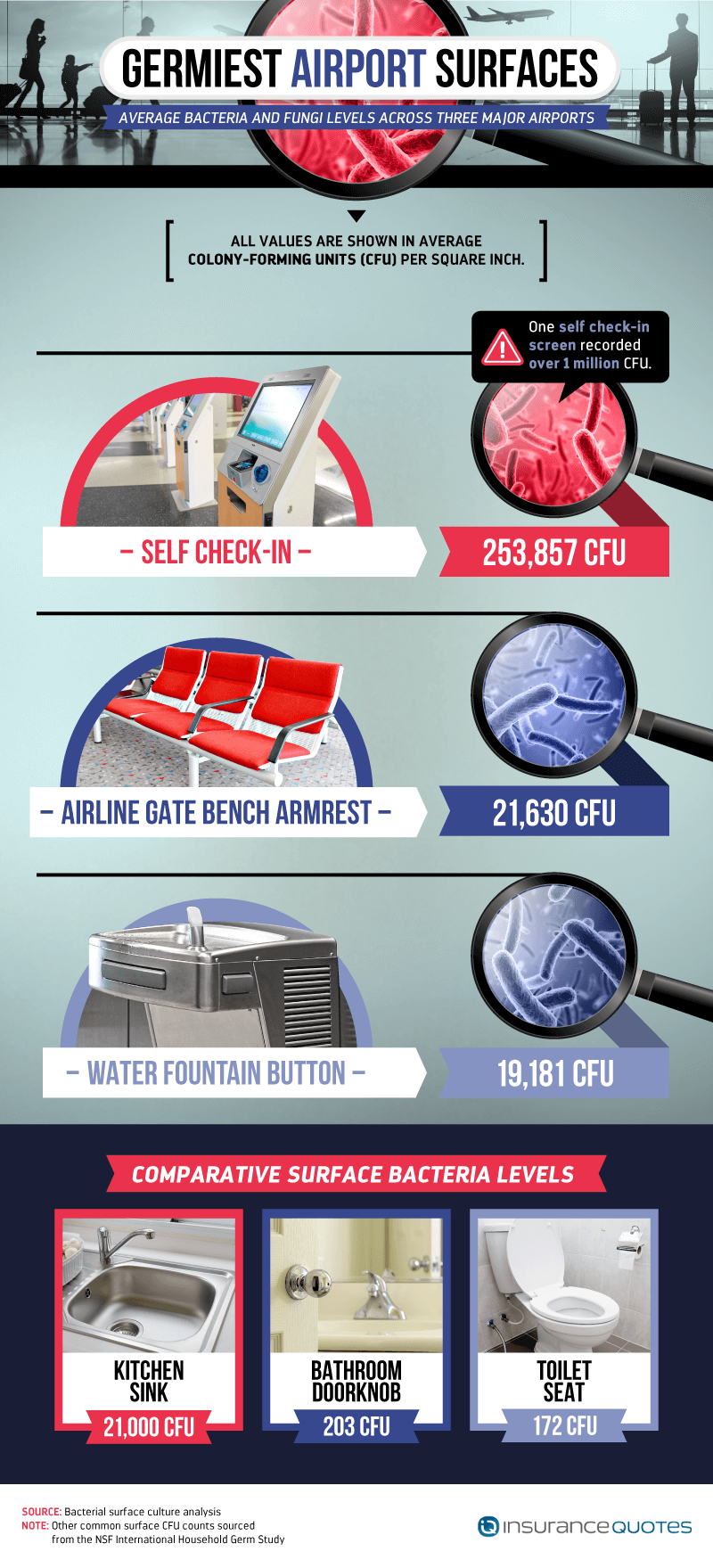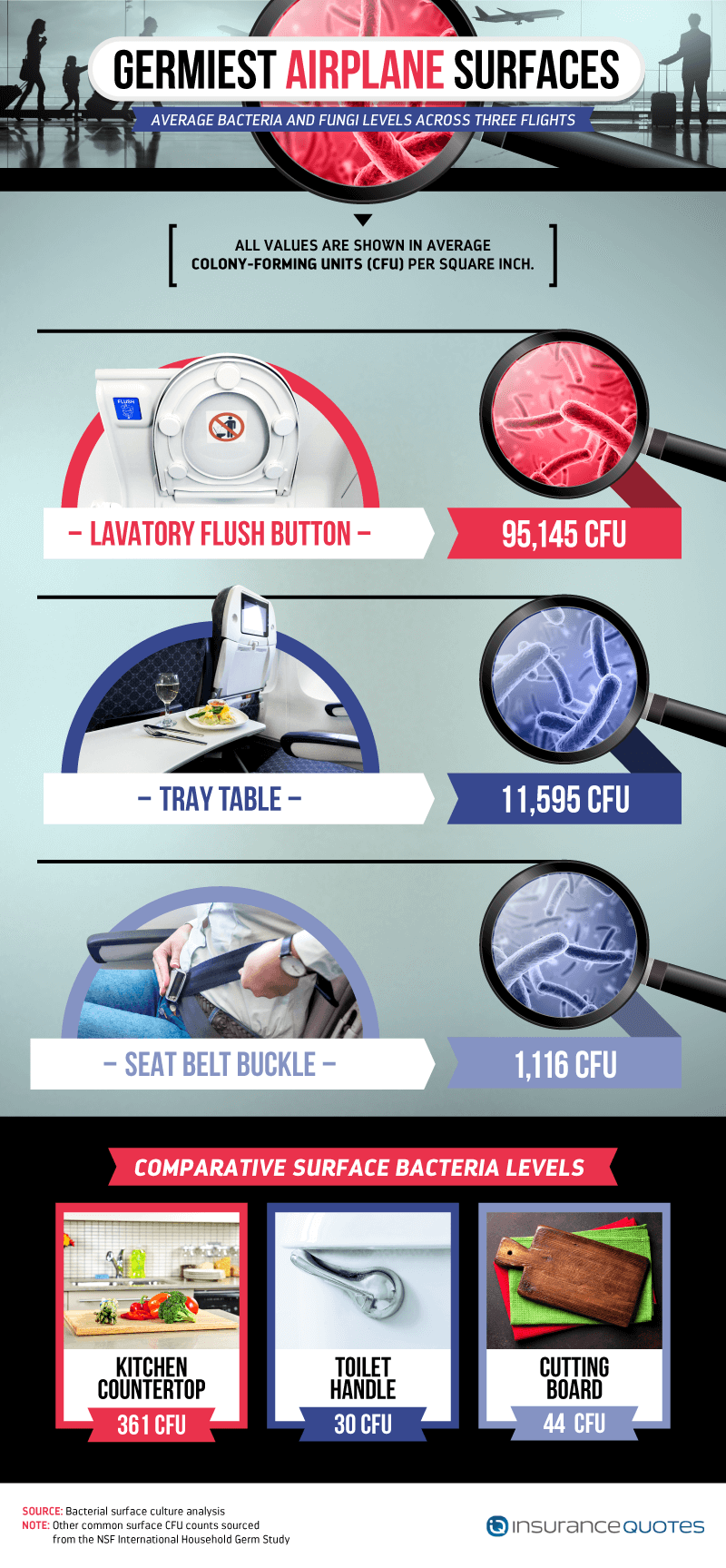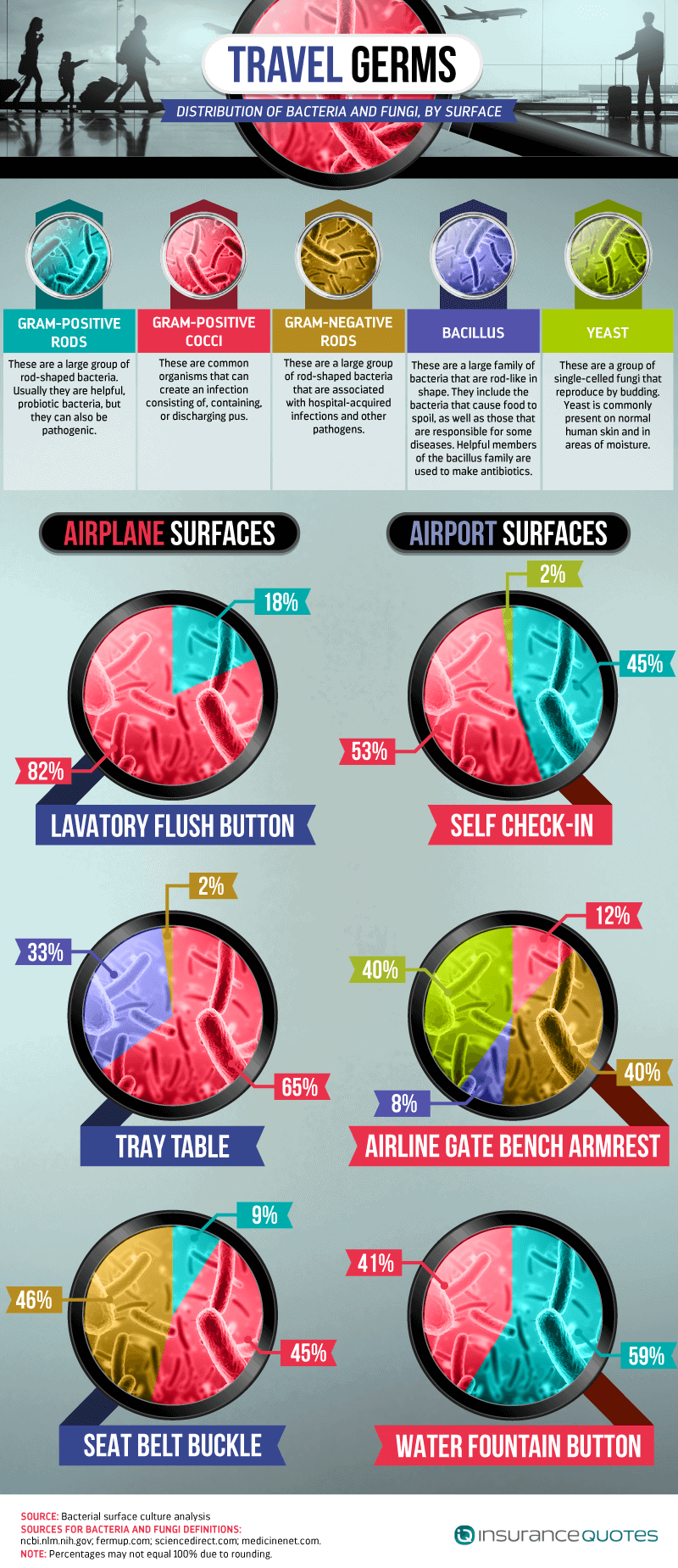Germs at the Airport: The Germs that Travel with Us

Your bags are packed, travel insurance is purchased, and there’s plenty of time before your flight to make it through the dreaded security line during the peak holiday season. Vacation mode is finally on, and your worries are at ease – but should they be?
Although 2017 was historically the safest year for commercial air travel, travel dangers aren’t always as large as the planes we fly in. With the number of travelers increasing every year for the past nine years, it’s easy to see the increased foot traffic through airports. What we can’t see are the risks that come with the travelers – the germs brought in by passengers and left waiting for their source of transportation: you.
Over this busy holiday season, we conducted 18 tests across six surfaces from three major U.S. airports and airline flights. We sent our swabs to the lab and found the average number of viable bacteria and fungal cells per square inch, or colony-forming units (CFU), to see how clean traveling really is. Keep reading to see which surfaces were the dirtiest and what germs you may have met along the way.
Check Out All the Germs at Check In

The Hartsfield-Jackson International Airport in Atlanta has been the busiest airport in the world since 1998, with the latest data reporting over 104 million passengers passing through in 2016. With mass amounts of traffic, self check-in kiosks are the quick stop for many flyers. The kiosks may offer more convenience, but at what cost? According to our research, the average self check-in screen contained 253,857 CFU – over 13 times more than the average CFU of an airport water fountain button. One check-in screen recorded over 1 million CFU. In comparison, an average of only 172 CFU are found on toilet seats.
Kitchen sinks and armrests on airline gate benches were far from similar, except when it came to average CFU levels. Despite the kitchen being the most contaminated place in homes and housing more bacteria than a toilet seat, armrests were even dirtier. Food remnants and dirty dishes left an average of 21,000 CFU in kitchen sinks – 630 CFU less than airline gate bench armrests.
Flying the Sickly Skies: Germs on a Plane

Airports see a lot more traffic than airplanes; therefore, it makes sense the average CFU found in planes is a lot less. However, they’re still pretty high compared to most common household surfaces. Lavatory flush buttons were the dirtiest, with an average of 95,145 CFU, while a kitchen countertop had an average 361 CFU. It’s often thought airplanes are cleaned between each flight, but the FAA actually doesn’t regulate or inspect aircraft cleaning. Each airline can decide how often and how well an airplane is cleaned, so if the turnaround time between flights is low, the plane may not be cleaned at all. Even when a plane is cleaned, general cleaners are used rather than stronger disinfectants, leaving dangerous germs right in your lap.
No Need to Go Beyond the Surface

Germs and bacteria have a bad reputation – after all, they’re the ones that make us sick, right? Not all germs and bacteria are harmful to humans, however. In fact, some bacteria are needed for our bodies to work properly, and not having enough is what can make us sick. These disease-fighting bacteria are usually gram-positive rods – helpful, probiotic bacteria. Don’t let your guard down fully, though – they can also be pathogenic. They were most likely to be found on airport water fountain buttons, making up 59 percent of CFU.
Gram-positive cocci are from the same family of bacteria with a different cell shape but are far more dangerous. Many infections can stem from these bacteria, including pneumonia, skin, ear, and sinus infections, food poisoning, meningitis, bacteremia, and toxic shock syndrome. Gram-positive cocci were found on all surfaces tested in the airport and on the plane – the greatest percentages found on lavatory flush buttons (82 percent) and tray tables (65 percent).
One-third of the bacteria found on tray tables were bacillus – bacteria that cause food to spoil and some diseases in humans. While there is a chance these bacteria can cause anthrax and be involved in various infections, some strains aide in digestion.
A bench armrest at an airport gate was the only place with a large collection of yeast – these fungi made up 40 percent of the CFU tested there. Luckily, yeast is a common fungus found on human skin and areas prone to moisture and are typically harmless. An accumulation of yeast can lead to infections but are unlikely to develop just leaning on an armrest.
The last germ we screened for was also the most dangerous. Gram-negative rods cause infections that are most common in health care settings – pneumonia, bloodstream infections, wound or surgical site infections, and meningitis. On top of causing serious infections, these bacteria are resistant to multiple drugs and can even resist newer ones. Seat belt buckles were where they were most commonly found, making up 46 percent of total CFU. Armrests on airline gate benches were also popular homes to these pesky germs – 40 percent of the bacteria tested were found to be gram-negative rods.
On the Road or in the Air
Germs are everywhere and unavoidable, but certain surfaces are clearly riskier than others. Self check-in kiosks had the largest collection of bacteria most likely to make you sick. Opting for the faster route may be logical if you’re short on time or just hate waiting in lines, but be cautious of the risk. Carry sanitizer with you when traveling, or one of the millions of germs you come in contact with may have you exchanging vacation days for sick days.
Staying protected when traveling is important – whether it’s risks like weather, accidents, or sickness, travel insurance can help make sure your vacation doesn’t become a financial loss. But with all the germs traveling with you, medical insurance may be just as important. At insuranceQuotes you can easily shop the widest network of carriers and agents in the industry so you can find the best policy for you. Visit us online today.
Methodology
We conducted 18 gram and stain culture swab tests across six surfaces. Each surface was swabbed three times at three major U.S. airports or on different major airline U.S. flights. Colony-forming units per square inch were averaged for each surface type. Individual surfaces were chosen based on perceived traffic and accessibility.
It is possible that with a larger sample size of surfaces, we could have gained more insight into CFU levels. No statistical testing was performed, so the claims listed above are based on means alone. As such, this content is exploratory.
Sources
- http://www.nsf.org/newsroom_pdf/2011_NSF_Household_Germ_Study_exec-summary.pdf
- https://www.sciencedirect.com/topics/biochemistry-genetics-and-molecular-biology/gram-positive-cocci
- http://fermup.com/blog/what-does-gram-positive-mean/
- https://www.medicinenet.com/script/main/art.asp?articlekey=6051
- https://www.medicinenet.com/script/main/art.asp?articlekey=10960
- https://www.forbes.com/sites/niallmccarthy/2018/01/02/2017-was-the-safest-year-in-the-history-of-commercial-air-travel-infographic/#153ad5b260d4
- https://www.local10.com/news/national/more-than-100-million-americans-to-travel-over-holidays
- https://www.cnbc.com/2017/12/19/why-the-atlanta-airport-the-busiest-in-the-world.html
- https://www.healthline.com/health/germy-places#kitchen
- https://www.usatoday.com/story/news/nation-now/2017/03/23/your-iphones-dirtier-than-toilet-and-so-these-other-everyday-items/99530570/
- http://healthcare.bioquell.com/en-us/resources-and-support/efficacy/bacteria/gram-positive-rods
- http://www.fpnotebook.com/id/Bacteria/GrmPstvBctr.htm#fpnContent-panel-id_0
- https://medlineplus.gov/staphylococcalinfections.html
- https://wwwnc.cdc.gov/travel/diseases/pneumococcal-disease-streptococcus-pneumoniae
- https://www.medicinenet.com/script/main/art.asp?articlekey=10960
- https://www.ncbi.nlm.nih.gov/books/NBK7699/
- https://www.medicinenet.com/script/main/art.asp?articlekey=6051
- https://www.cdc.gov/hai/organisms/gram-negative-bacteria.html
Fair Use Statement
Instead of sharing germs, feel free to share this study. We permit you to use the images and content here for noncommercial purposes. Just don’t forget to link back to this page to give the authors proper credit.
